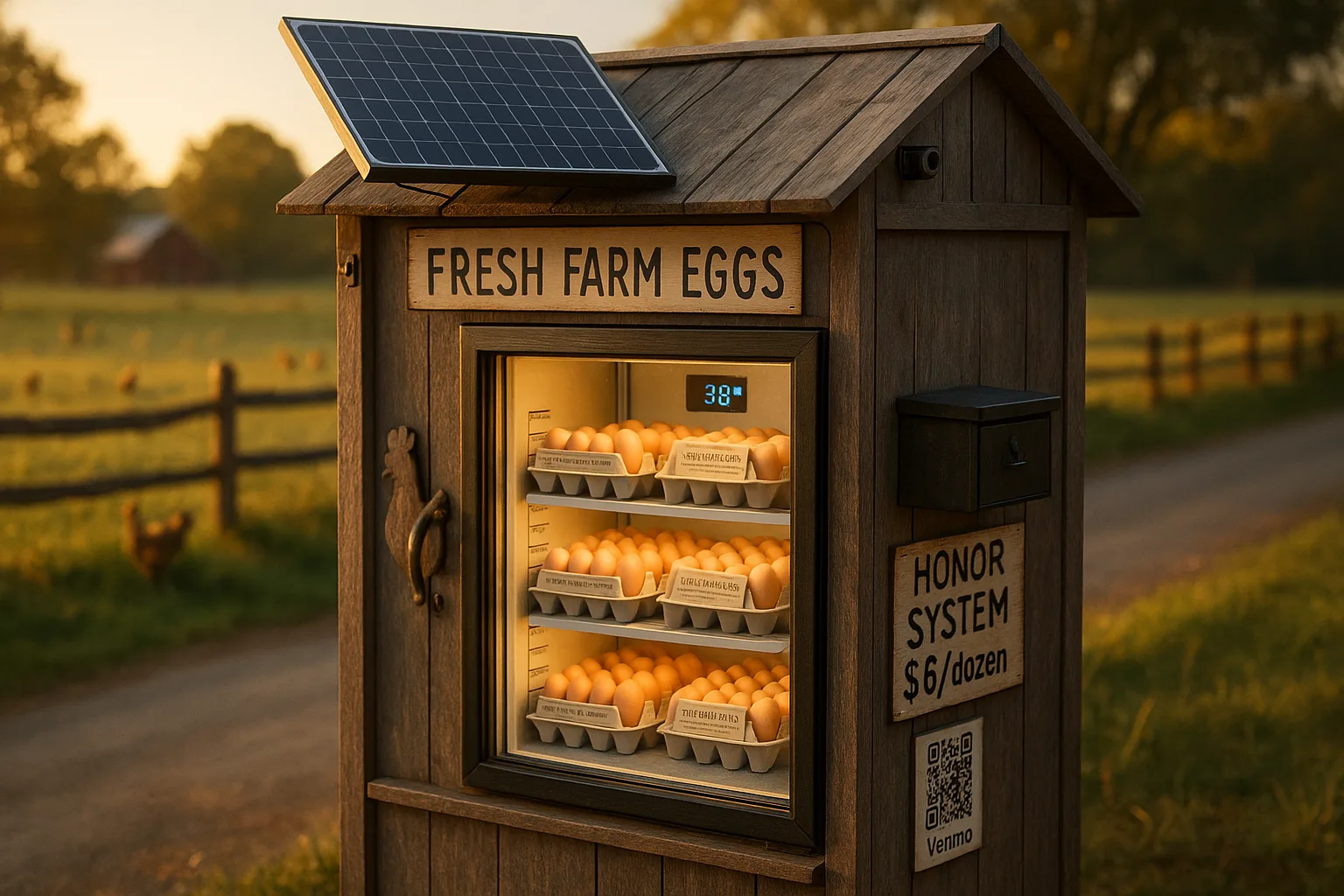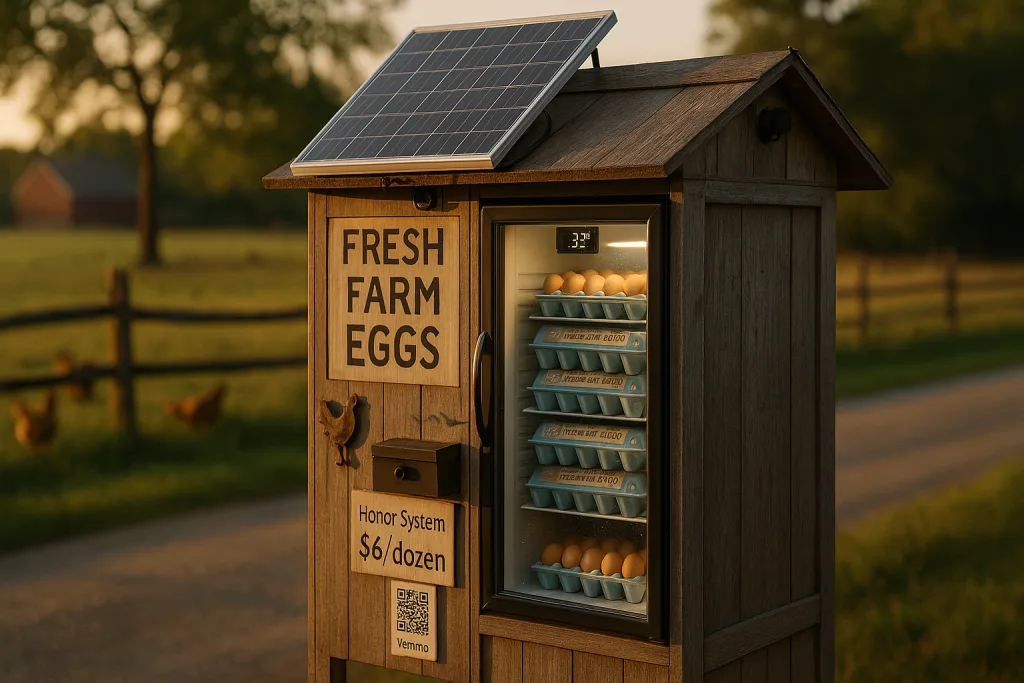The Complete Guide to Building a Profitable DIY Egg Station

In recent years, the global egg market has experienced significant disruptions. Commercial egg prices have become increasingly volatile due to outbreaks of avian flu and vulnerabilities in the supply chain. These challenges have exposed the risks associated with concentrated production models.
For example, during the 2024–2025 avian flu crisis, over 50 million egg-laying birds were lost across the U.S. in just a few short months. This catastrophic loss not only drove up prices but also highlighted the fragility of relying on large-scale industrial farms for such a basic staple.
This situation has created a unique opportunity for small-scale producers—particularly those operating flocks of fewer than 3,000 hens—to step into the gap. By establishing direct-to-consumer sales through well-designed DIY egg stations, backyard farmers can contribute to local food resilience, build strong community ties, and generate steady income from their operations.
DIY egg stations are more than just a way to sell eggs—they’re a pathway to economic independence, sustainable agriculture, and food sovereignty at the local level.
Planning Your Egg Station Business
Regulatory Landscape
Before launching your egg station, it’s essential to understand the legal requirements governing egg sales in your state. Regulations vary widely, so always check with your local agricultural extension office or health department.
Licensing Requirements:
- South Dakota: Requires an annual license costing $10–$100; includes mandatory candling certification.
- New York & Pennsylvania: Exempt small producers (under 3,000 hens) from USDA grading but enforce strict labeling standards.
- Other States: Some require inspections, while others allow ungraded egg sales with proper labeling.
Critical Compliance Points:
All states require that egg cartons include the following:
- Producer name and full address
- Pack date
- “Keep Refrigerated” statement
- Safe handling instructions
These labels must be clear and legible to meet health code standards.
Facility Needs:
Even small-scale operations need a designated packing area. This should include:
- Washable surfaces
- Handwashing station (or nearby access)
- Storage for clean cartons
- Refrigeration unit or cooler that maintains eggs below 45°F
Financial Considerations
Starting an egg station is relatively affordable compared to other agricultural ventures. Here’s what you need to know:
Startup Costs:
- Basic roadside cooler: $50–$150
- Solar-powered cabinet: $300–$600
- Self-serve farm stand: $800–$1,500
The primary expense is often refrigeration, especially if you opt for a solar-powered solution or commercial fridge.
Profit Potential:
With pasture-raised eggs selling for $5–$8 per dozen, a modest flock of 50 hens can yield $150–$300 per week during peak laying season.
Let’s break it down:
- 50 hens x 70% lay rate = ~35 dozen/week
- At $6/dozen = $210/week
- After subtracting feed costs (~$0.15/dozen), packaging (~$0.25), and labor (~$1), profit margins remain healthy.
Recordkeeping Essentials:
To maintain profitability and compliance:
- Track feed costs (typically 60% of expenses)
- Monitor mortality rates
- Record lay percentages (aim for 85% at peak)
- Log refrigerator temperatures daily
Constructing Your DIY Egg Station: Three Tiered Approaches
There are three main types of DIY egg stations to consider, depending on your budget, scale, and desired level of automation.
1. Basic Roadside Cooler ($50–$150)
Ideal for beginners or small flocks.
Components:
- Insulated beverage cooler
- Digital thermometer
- Freeze packs
- Money box or lockable container
Operation:
- Pre-chill eggs to ≤45°F before placing in cooler
- Place ice packs above eggs to keep them cool without freezing
- Rotate stock daily
Security:
- Add a hasp and padlock
- Use clear acrylic fronts for visibility
- Include signage with pricing, contact info, and usage instructions
Pros:
- Low cost
- Easy to set up and move
- Great for testing demand
Cons:
- High maintenance (daily ice swaps)
- Limited capacity (12–24 dozen)
- Less temperature control

2. Solar-Powered Refrigerated Cabinet ($300–$600)
Perfect for off-grid locations or remote homesteads.
Core Components:
- 12V compressor fridge (e.g., Dometic CFX)
- 100W solar panel
- Deep-cycle battery
- Wi-Fi-enabled thermometer with remote alerts (e.g., SensorPush)
Display:
- Slanted shelves with anti-roll rails
- Integrated payment system (optional)
Advantages:
- Maintains consistent 38–40°F without ice
- Low maintenance once installed
- Can operate independently of grid power
Capacity:
- Holds 30–60 dozen eggs
3. Self-Serve Farm Stand ($800–$1,500)
Best for high-volume sales or permanent setups.
Structure:
- Insulated shed with locking Dutch door
- Glass-front refrigerator unit
- Dry-erase inventory board
- Security camera
Value-Adds:
- Egg recipe cards
- Loyalty punch cards
- QR code for pre-orders or social media engagement
Compliance:
- Ensure every carton includes required labeling
Features:
- Commercial-grade refrigeration
- Customizable design
- Year-round operation
Capacity:
- 60–100 dozen eggs
Table: Egg Station Options Comparison
| Feature | Basic Cooler | Solar Cabinet | Farm Stand |
|---|---|---|---|
| Temp Control | Ice packs (≥45°F) | Compressor (38°F) | Commercial fridge |
| Investment | $50–$150 | $300–$600 | $800–$1,500 |
| Daily Maintenance | High (ice swap) | Low (auto) | Very low |
| Capacity (dozen) | 12–24 | 30–60 | 60–100 |
Operational Excellence: From Coop to Carton
Collection Protocols
Proper egg collection is critical for quality and safety.
- Collect eggs at least twice daily
- Discard cracked or leaking eggs immediately
- Avoid floor eggs: they carry 80% higher contamination risk
- Provide one nest box per 4–5 hens
- Keep bedding fresh and dry
Cleaning Methods
Cleaning procedures depend on your state’s regulations.
- Washing Choice: Optional in NY/PA but mandatory in SD for licensed dealers
- Correct Technique: Use water 20°F warmer than egg temperature to prevent bacterial ingress
- Sanitizing: Use food-grade sanitizer—never soak eggs
- Drying: Air-dry completely before refrigeration on racks
Storage & Packaging
Maintaining cold chain integrity is vital.
- Refrigerate eggs at ≤45°F within 48 hours of laying
- Use new or thoroughly sanitized cartons
- Remove all previous farm information from reused cartons
- Store eggs large-end up to preserve air cell
- Label with:
- Pack date
- “Use by” date (max 45 days post-wash)
Navigating Legal Requirements
Non-Negotiable Labeling
Your egg cartons must include the following:
- “EGGS” in 3/8-inch font
- Farm name + full address
- Pack date
- “KEEP REFRIGERATED” or equivalent
- Safe handling statement in outlined box:
“SAFE HANDLING INSTRUCTIONS: To prevent illness from bacteria: keep eggs refrigerated, cook eggs until yolks are firm, and cook foods containing eggs thoroughly.”
Prohibited Claims
Avoid making these claims unless you have documentation or lab results to back them up:
- Nutritional superiority (“higher omega-3”)
- Unverified certifications (“organic” without official status)
- Comparative adjectives (“fresher,” “healthier”)
Allowed Descriptors
You may use the following terms truthfully:
- “Pasture-raised hens”
- “Non-GMO fed”
- “Ungraded” (unless officially sized)
Marketing & Customer Retention
Pricing Strategy
Understand your market:
- Conventional eggs: $2–$4/dozen
- Pasture-raised: $5–$8/dozen
Factor in your costs:
- Feed: $0.15/dozen
- Cartons: $0.25
- Labor: $1
Offer value-add options:
- Jumbo eggs at a 25% premium
- Bulk discounts (e.g., buy 6, get 1 free)
Promotion Tactics
Build trust and visibility:
- Share coop photos on Instagram/Facebook (67% of buyers prefer seeing source)
- Offer hard-boiled egg samples at markets
- Partner with local cafes for “farm source” displays
- Implement loyalty programs (e.g., punch cards: buy 10, get 1 free)
Demand Generation
Drive traffic and repeat business:
- Install eye-catching signage with “FARM EGGS” in large letters
- Use rotating A-frame boards weekly
- Offer subscription models (weekly porch delivery)
Sustainability & Expansion
Scaling Considerations
Once your station is running smoothly, consider expanding:
- Add waterfowl eggs (duck, quail) for niche markets
- Develop value-added products like pickled eggs or baked goods
- For flocks over 100 hens, invest in automated collection systems
Seasonal Adaptation
Adjust your strategy with the seasons:
- Summer: Increase ice frequency; add shade canopy
- Winter: Install path lighting; offer egg-based recipes
- Holidays: Create gift packs for Easter, Christmas, and Mother’s Day
Food Safety Auditing
Maintain high standards:
- Monthly swab tests for Salmonella ($25/test kits)
- Maintain visitor log at farm stands
- Document refrigeration temps daily
Conclusion: Rebuilding Local Food Systems
The DIY egg station represents more than just a side hustle—it’s a powerful tool for rebuilding localized food systems. As avian flu continues to disrupt industrial production (with 28 million hens lost in January–February 2025 alone), your small station becomes a community lifeline.
Start modestly with a cooler system, master your state’s regulations, and prioritize refrigeration consistency. With commitment to both quality and compliance, your backyard operation can evolve into a cherished community asset.
“The benefits of small-scale distribution became evident during the avian flu crisis. While U.S. prices soared, Canada’s network of small farms maintained stable supply.”
By building your own egg station, you’re not just selling eggs—you’re contributing to a resilient, sustainable future for your community.

